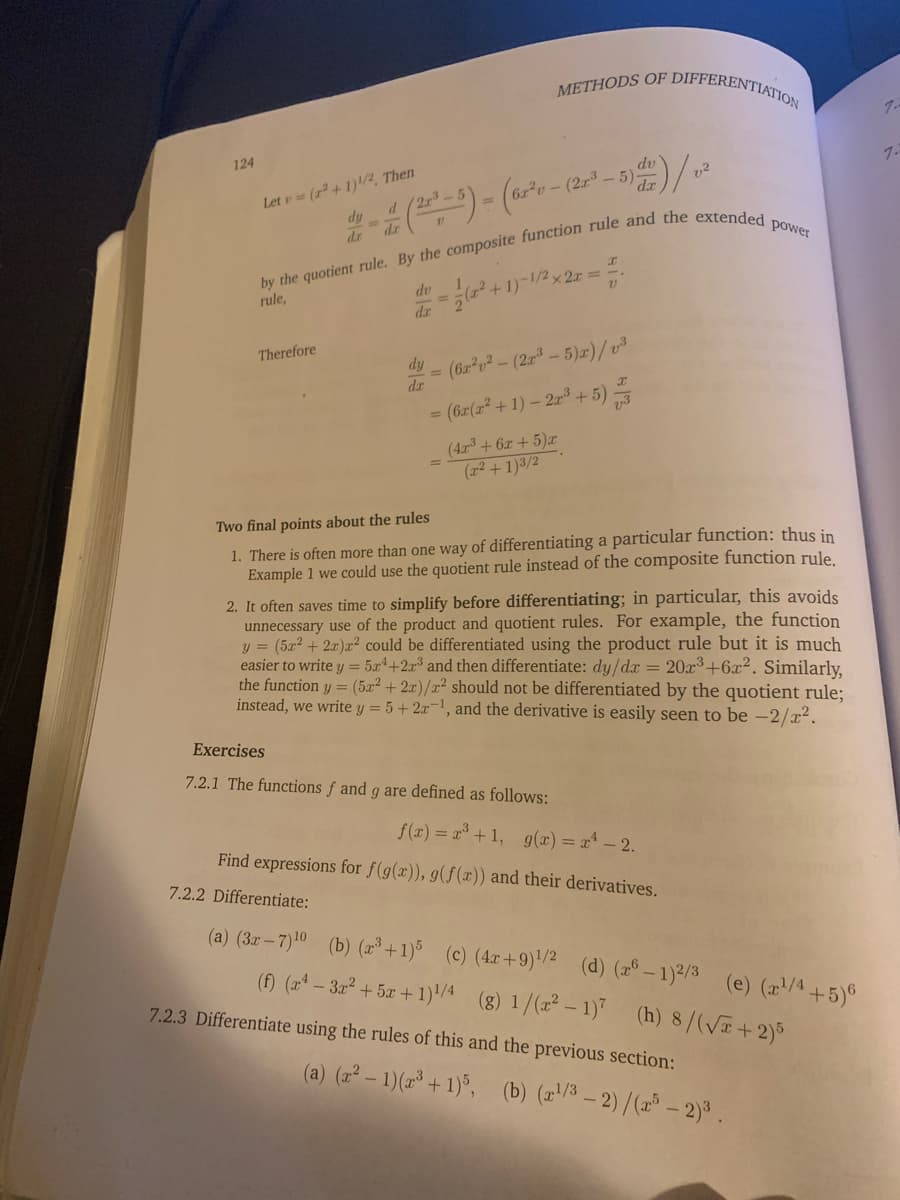I need help with problem 7.2.2 D as well as G
Algebra & Trigonometry with Analytic Geometry
13th Edition
ISBN:9781133382119
Author:Swokowski
Publisher:Swokowski
Chapter9: Systems Of Equations And Inequalities
Section9.9: Properties Of Determinants
Problem 46E
Related questions
Question
I need help with problem 7.2.2 D as well as G

Transcribed Image Text:METHODS OF DIFFERENTIAT
ATION
124
Let e= (r + 1)!/2, Then
dy
dr
dv
1.
dr
power
dv
%3D
-1/2x 2x =
rule,
dr
Therefore
dy
(62 v²-(23-5)r)/v3
%3D
dr
= (6z(r +1) – 2a³ + 5)
(4ar3 + 6x + 5)x
(r2 + 1)3/2
Two final points about the rules
1. There is often more than one way of differentiating a particular function: thus in
Example 1 we could use the quotient rule instead of the composite function rule.
2. It often saves time to simplify before differentiating; in particular, this avoids
unnecessary use of the product and quotient rules. For example, the function
y = (52 + 2r)r² could be differentiated using the product rule but it is much
easier to write y = 5x*+2x³ and then differentiate: dy/dx = 20x3+6x². Similarly,
the function y = (5x² + 2x)/x² should not be differentiated by the quotient rule;
instead, we write y = 5+2x¬1, and the derivative is easily seen to be -2/x².
Exercises
7.2.1 The functions f and g are defined as follows:
f(x) = a° +1, g(x) = x* – 2.
Find expressions for f(g(x)), g(f(x)) and their derivatives.
7.2.2 Differentiate:
(a) (3z–7)10 (b) (³ + 1)% (c) (4x+9)'/2 (d) (2° – 1)2/3 (e) (a/4+5)6
(Đ ( - 3ar + 5a + 1)/4 (8) 1/(x² – 1)* (h) 8/(V+2)5
7.2.3 Differentiate using the rules of this and the previous section:
(a) (2² – 1)(2³ + 1)°, (b) (/3 - 2)/(2 - 2)3.
Expert Solution
Step 1
(d)
The given function is .
Evaluate the derivative of the given function as follows.
Therefore, the derivative of given function is .
Step by step
Solved in 2 steps

Knowledge Booster
Learn more about
Need a deep-dive on the concept behind this application? Look no further. Learn more about this topic, advanced-math and related others by exploring similar questions and additional content below.Recommended textbooks for you

Algebra & Trigonometry with Analytic Geometry
Algebra
ISBN:
9781133382119
Author:
Swokowski
Publisher:
Cengage

Algebra & Trigonometry with Analytic Geometry
Algebra
ISBN:
9781133382119
Author:
Swokowski
Publisher:
Cengage